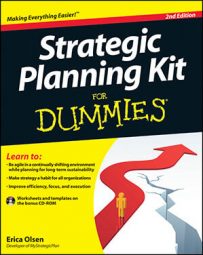From a strategic planning perspective, you need to look at what tangible assets you have versus what you need to achieve your strategic plan. Resources are tangible assets — any physical or quantifiable assets that your organization uses to bring revenue into your business. Some assets, such as your brand, are intangible but still have a quantifiable value to your company, just like your long-standing customer relationships.
You may need to come back to this section after you’ve developed more of your plan. But taking stock of where you are now can be helpful in your planning process. Specifically, you need to look at the following:
What tangible assets you have in your company right now that allow you to produce your product or service
What tangible assets you need to continue to provide and exceed your current service levels
Create a page titled “Resources.” List the assets you have (strengths), the assets you need (weaknesses), and the assets you desire. Consider coming back to this page when you’re further along in your plan development.
To help identify your business resources, group them under the following categories:
Financial resources: These resources include all the items available to finance or pay for your strategic decisions. Existing resources include cash balances, lines of credit, other loans, owner’s equity, and credit agreements with your vendors.
Intangible resources: Your intangible resources are everything that you can’t touch or feel but that you know has value to your business. These sources include
Brands: Your standing and awareness in the marketplace is your brand.
Goodwill: Goodwill is the difference between the value of your tangible assets and the actual market value of your business.
Intellectual property: When you’re managing your knowledge, you actually turn a capability into a resource. Intellectual property also includes patents, trademarks, and copyrights.
Reputation: Your reputation is your standing in your community and your industry.
Physical resources: Your physical resources include everything you have and use to deliver your products and services. These resources also include
Production facilities, which may include buildings, plants, machinery, capacity, investment and maintenance, quality, and organization of your production processes
Information technology (IT), which includes systems, computers, and critical software in use in the organization and also encompasses integration with customers and suppliers

